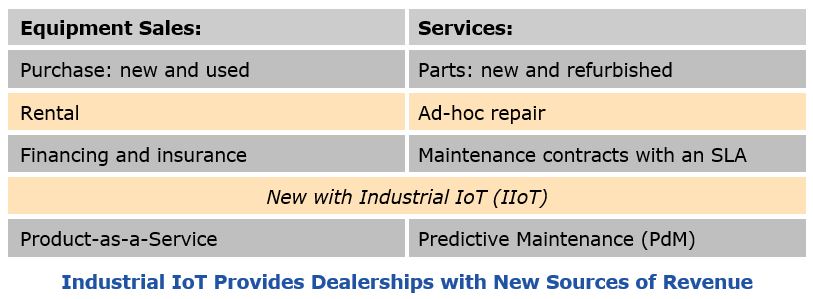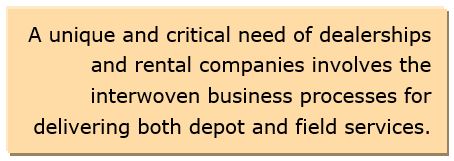Part 2 of a three part series on the impact of IIoT on OEMs and their dealerships.
Part 1 is here. Original equipment manufacturers (OEM) are starting to offer IIoT-enabled remote monitoring and analytics services on a subscription basis that identify an issue before it harms the equipment or cascades into a major incident. Success in preventing a failure usually requires the OEM’s dealership or rental company to provide maintenance services to its local end-user customers with well-trained field service technicians to make repairs. This benefits all parties by providing increased revenues for the equipment dealer or rental company while improving customer satisfaction and retention by helping the equipment users avoid costly unplanned equipment downtime.
 Complex Dealership Business Processes for Maintenance
Complex Dealership Business Processes for Maintenance 
The table above provides a basis for describing the complex set of maintenance-related business processes for a dealership. These processes demand a hybrid combination of maintenance management involving assets onsite in the depot, and field service management (FSM) for repairs at the customers’ locations. The interwoven depot and field service represents a unique and critical need of dealerships and rental companies.
For field service repairs, the dealership/rental company must:
- Send a technician with the right skills, parts, documentation, and tools at the agreed time for service at the customer’s location
- Enable the technician to upsell by expanding the scope of the initial work order as the need or opportunity arises
For depot refurbishments and upgrades, the company must:
- Refurbish used equipment, subsystems and parts from trade-ins, rental returns and other sources to function as new with a warranty
- Maintain or upgrade a client’s equipment or parts, and return them to the respective owner
In both cases, the organization must:
- Bill the customer correctly based on the client’s specific service agreement and actual services delivered
- Track the history, costs and related asset information for assessing future repairs and evaluating end-of-life
During these activities, the dealership/rental company tracks ownership for each specific customer and its inventory. Site-specific industry requirements, local customs, and individual interests are nuances that must be layered on the basic business processes.



 The table above provides a basis for describing the complex set of maintenance-related business processes for a dealership. These processes demand a hybrid combination of maintenance management involving assets onsite in the depot, and field service management (FSM) for repairs at the customers’ locations. The interwoven depot and field service represents a unique and critical need of dealerships and rental companies.
The table above provides a basis for describing the complex set of maintenance-related business processes for a dealership. These processes demand a hybrid combination of maintenance management involving assets onsite in the depot, and field service management (FSM) for repairs at the customers’ locations. The interwoven depot and field service represents a unique and critical need of dealerships and rental companies. 
